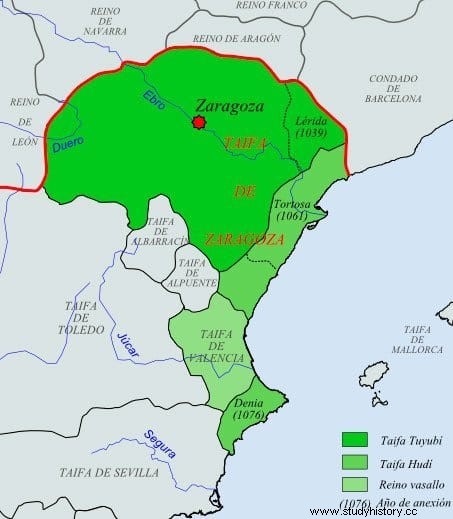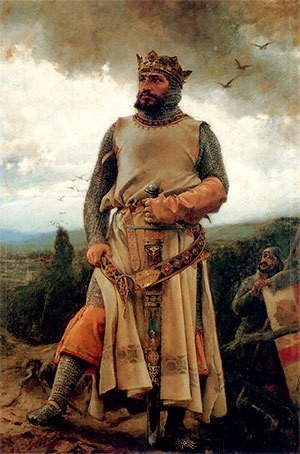In the year 1110 the Almoravids conquered the Taifa of Zaragoza . However, in that territory they ran into a very dangerous rival, the king of Aragon Alfonso I (1104-1134), known as the Battler. Alfonso I, apparently had in his mind the idea of carrying out a crusade, which would begin in Hispania, fighting against the Muslims of the Ebro valley, and would end, logically, in Jerusalem. In the first years of his reign he occupied the towns of Egea (1105) and Litera (1107). But the complicated problems arising from his marriage to the queen of Castile and Leon, Urraca, took him away from Aragon for a few years. However, in the year 1117 he resumed the offensive against the Muslims, occupying the Belchite square. The following year, in the year 1118, after a long siege, Zaragoza, which was the capital of the superior mark of al-Andalus, fell into his power, culminating the conquest of Zaragoza in incorporating him into his kingdom. His advance through the Ebro valley continued, conquering, in the year 1119, Tíldela, Tarazona, Rueda and Borja. A year later, Alfonso I defeated the Islamists in the battle of Cutanda , while he occupied the cities of Soria, which would later pass to Castile, and Calatayud. In 1121, he became the owner of Daroca.
In 1126, he carried out an expedition through the lands of al-Andalus, from which he returned with many Mozarabs, who collaborated in the repopulation of the middle valley of the Ebro. In 1134, Alfonso I was defeated and killed near Fraga. Having no children, Alfonso I bequeathed his kingdom to the great international military orders.

The territory won by Islam by the Aragonese monarch was very extensive, but above all very rich, both for its cities and towns and for the abundant irrigated areas that he had. A large part of the Muslim population remained in his place, although they were forced to leave some cities such as Zaragoza . Numerous settlers flocked to the middle valley of the Ebro, some originally from the Pyrenean regions, others from the south of France. The noble magnates received important concessions. In the southern part of the kingdom, the dominant role was played by the knights, which explains why this area is called the extremadura aragonesa , due to its similarity with the lands of the same name in Castilla y León.

In the kingdoms of Castilla y León, on the death of Alfonso VI, his daughter Urraca (1109-1126) acceded to the throne. Widow of the French nobleman Raimundo de Borgoña, Urraca married, in second marriage, with the king of Aragon Alfonso I. But that marriage was a complete failure. A contemporary chronicle spoke, very expressively, of the "damned and uncommunicated weddings." Urraca's reign, on the other hand, witnessed violent uprisings by the bourgeoisie of Sahagún and Santiago de Compostela. These uprisings, which were joined by people from the countryside and some clerics, were directed against the gentlemen on whom they depended:the abbot of the Benedictine monastery of Sahagún, in the first case, and the archbishop of Santiago, Diego Gelmírez, in the second. After a few years of bitter fighting, the revolts were put down. The objective of the rebels was not so much to fight against the feudal lords but to obtain guarantees for their economic expansion. Urraca also had to face the secessionist attitude of an important sector of the Galician nobility, led by Pedro Fróilaz. At the same time, the county of Portugal was gaining autonomy, headed by Teresa, her sister, and Enrique de Borgoña. As far as relations with the Almoravids are concerned, there were hardly any changes in the border lines that separated the two.
